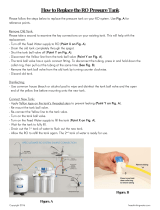
8
Step E – Clean the filter housings (bowls)
with a mild soap solution and
rinse with water. Check O-rings
and lubricate with water soluble
lubricant. KY Jelly
®
, canola oil
or other water based lubricants
may be used. Petroleum
based lubricants (such as
Vaseline
®
) must not be used.
Caution: Before re-installing the filter bowls back on to the sys-
tem, check O-rings to make sure they are still in place.
Step F – Insert a new sediment filter
(cloth like appearance) into
the 1st filter housing which is
the one on the water inlet side
(green tubing from the Adapt-
A-Valve™) of the RO system
and re-install housing.
Step G – Insert the new Carbon Block
filter (White end caps & plastic netting) into the second and
third filter bowls and re-install housings.
Do not over-tighten filter housing, overtightening may damage
O-ring(s), cause water leaks, or affect system performance.
Step H – Turn water supply on to the unit by turning the knob on the
Adapt-A-Valve™ counterclockwise.
Step I – Open the RO faucet and leave it open until water begins to
trickle out (it will come out slowly).
Step J – Close the RO faucet allowing the storage tank to fill with
water. It may take 4 to 6 hours to fill the tank completely
depending on the production capability of the membrane,
local water temperature and water pressure.
6-Month System Maintenance
Order filter by calling Watts at 1-800-224-1299
Item Needed: EDP# 7100110
Includes:
• (1) Sediment Filter • (1) Carbon Block Filter
Step A – Turn off the incoming water supply to the RO by turning the
knob on the Adapt-A-Valve™ clockwise until it stops.
Step B – Open the RO Faucet and allow water to drain from the tank
until it is completely empty.
Note: Water may be saved in a container for drinking or to rinse
system parts.
Step C – Let system sit for 10 to 15
minutes after the tank is empty
to let the system depressurize
before attempting to remove
filter housings.
Step D – For more leverage you may
leave the RO module attached
to wall of cabinet. If you are
unable to access the module
while it is mounted, remove it
prior to changing filters. Start-
ing with the closest housing
(Stage 1), remove it by turning
it clockwise (left), empty water,
then discard filter. Continue on
to the 2nd housing (Stage 2)
and 3rd housing (Stage 3).
Note: If you own a 4-Stage system, it will not have the third
stage. A 4-Stage system has two vertical housings instead of
three.
Annual Maintenance
Order filter by calling Watts at 1-800-224-1299
Item Needed: # 7100115
1/2 cup of hydrogen peroxide or household bleach.
Includes:
• (1) Sediment Filter • (1) Membrane
• (1) Carbon Block Filters • (1) Final Inline Filter
Note: Sanitizing of unit is recommended.
Step A – Perform steps A through E in the Six Month System Main-
tenance.
Note: If not sanitizing the system skip to step H.
Step B – Remove the RO membrane from its housing and rest in a
clean sanitary place. (Refer to “Membrane Replacement”
section on Page 9 for directions on removing the mem-
brane). Replace cap onto empty membrane housing and
re-connect green tubing.
Step C – Leaving the filters out, replace Stage 1 and 2 empty filter
housings (hand tight) onto unit. Measure & pour either
1
⁄2
cup of hydrogen peroxide or common household bleach
into the 1st filter housing (Stage 1) and hand tighten onto
unit.
Step D – With the RO faucet in the closed position turn on the
incoming water supply to the system by turning the Adapt-
A-Valve™ counterclockwise. Wait 1 minute for the unit to
pressurize. Turn on the RO faucet and let the water run for
30 seconds. Turn off the RO faucet and let the unit rest for
2 minutes. Finally, open the RO faucet and let the water run
for 5 more minutes.
Step E – Turn off the incoming water supply to the system by turning
the Adapt-A-Valve™ clockwise until it stops. Keep the RO
faucet open until the storage tank is completely drained.
Step F – Open the membrane housing and re-install the RO mem-
brane while making sure not to kink the O-rings. (Refer to
“Membrane Replacement” section on Page 9 for directions
on installing the membrane). Tighten the cap back on the
housing and reconnect green tubing.
Step G – Remove filter housings Stage 1 and 2 and empty of water.
Caution: Before re-installing the filter bowls back on to the
system , check O-rings to make sure they are still in place and
lubricate with water soluble lubricant.
Step H – Insert the new sediment filter (cloth like appearance) into
the 1st filter housing which is the one on the water inlet
side (green tubing from the Adapt-A-Valve™) of the RO
system and re-install housing.
Step I – Insert the new Carbon Block filter (White End Caps) into the
2nd housing and re-install housing.
Do not over-tighten filter housing, overtightening may damage
O-ring(s), cause water leaks, or affect system performance.
Step J – The final in-line filter is located on the blue tube between
the storage tank and the RO faucet. Remove it by loosen-
ing the compression fittings on both ends of the filter and
replace with new filter. (Discard used final filter after sanitiz-
ing).
Note: The arrow on the final filter must be pointing towards the
RO faucet / away from the RO storage tank.
This is a good time to check the air pressure in your storage
tank. For instructions please see Page 9.
Step K – Follow Steps H through J in the Six Month System Mainte-
nance (Page 8) for startup directions.



















